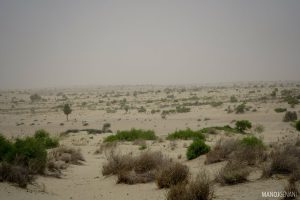Ask anyone who lives on the banks of the Kosi river in Bihar, and you will be told that floods devastate the area every monsoon, regardless of the party that is in power. Embankments are built and repaired, only to be washed away during the next flood. It is done all over again, year after year.
About this article
For the ruling party, it is the goose that keeps laying golden eggs, residents say, alluding to the widespread belief that every construction and repair contract involves kickbacks. For opposition party politicians, floods are an issue to be raised once every five years, before the polls. For residents, life continues between a rock and a hard place, as it has for decades.
The situation has been worse this year. The embankment repairs that ordinarily take place have been hit by the lockdown forced by the Covid-19 pandemic.

Nearly eight million people have already been affected by this year’s floods in Bihar, and at least 24 deaths reported – a large percentage of them along the Kosi, a river that flows from Nepal to join the Ganga in Bihar. Standing crops have been ruined in millions of hectares, a distressingly regular occurrence.
Residents spend half the year, every year, being displaced by floods, looking desperately for relief camps, staying in relief camps and then being stuck in them as the floodwaters refuse to recede.
![Villagers are forced to wade or use makeshift rafts to move out of their flooded homes [images by: Kailash Singh]](https://dialogue.earth/content/uploads/2020/08/India_Flood_Story_2020_Bihar_Kosi_Image_2_Kailash_Singh-2.jpg)
In much of northern Bihar, including the Kosi basin, rivers now flow at a level higher than the land around; dams stop the natural flow of silt, which raises the riverbed, which reduces the capacity of the rivers to carry water. So when it rains heavily in the monsoon months from June to September, embankments are breached or topped. Floodwaters cover the land and then cannot drain out because the river is at a higher level.
Official response
There are two sets of responses from the Bihar government. The first is to repair embankments and build new ones, then open relief camps for those displaced by the floods that overwhelm the defences. The second is to blame upstream Nepal for opening barrage gates, though the gates on the Kosi barrage are supposed to be operated jointly by India and Nepal.
Neither response looks at the problems or the potential solutions long term. Nor do they improve transboundary cooperation on flood management, though NGOs have been pushing for such cooperation for decades.
The Kosi is a river that has been changing its course over centuries and has always been prone to flooding. To handle this, a stretch of over 100 kilometres from the Kosi barrage in Nepal to Saharsa in Bihar was jacketed within embankments in the 1960s. In places, the embankments are 10 kilometres apart. Hundreds of villages were marooned between the riverbanks and the embankments. The rehabilitation of the villagers is a sorry saga that has continued for over five decades. Villagers continue to live within the embankments, they continue to get marooned and then flooded out almost every monsoon. Almost all residents are farmers, and they keep losing their crop to floodwaters year after year.
While the Kosi has always been flood-prone, the frequency and severity of floods increased dramatically after the construction of the barrage in Nepal and the embankments in both countries.
In India alone, the numbers of people affected are immense. Around half a million people in 400 villages spread across three districts of Bihar – Saharsa, Supaul and Madhepura – are affected every year.

Hundreds of millions are spent every year in futile attempts to shore up the embankments. That is the big political issue in the region – opposition politicians join the flood displaced in alleging that corruption has led to substandard repair work. Ruling party politicians say the opposition is raising the issue of floods because it has nothing else to talk about. With elections to the Bihar state assembly due in a few months, the rhetoric is shriller this year.
Ram Babu Yadav, a farmer who lives between the Kosi and its western embankment in southern Marauna panchayat of Supaul district, said, “The government never compensates us properly for the crop loss. Politicians take our votes but have not solved our problems in any permanent way. We get lots of assurances when our area is flooded, but as soon as the water goes down those assurances are buried in the soil.”
Laldev Yadav, a farmer from the nearby northern Marauna panchayat, said, “It is more than 70 years since [India’s] independence. We have not managed independence from floods.”
Mahendra Yadav of the NGO Kosi Navnirman Manch, who has been working with the flood victims for many years, added, “The government and the officials have no strength of purpose. Both ruling party and opposition politicians think of these people as vote banks. That is why there is no permanent solution.”
Yadav pointed out that a special government body was set up to rehabilitate Kosi flood victims as early as 1987. The authority made a number of recommendations, the then state government accepted them, but there has been no implementation to date. Instead, every year people who have lost their homes and crops due to flooding have to run from one bureaucrat to another in an effort to get their compensation on time.
![<p>People marooned in the 2020 floods along the Kosi river [image by: Kailash Singh]</p>](https://dialogue.earth/content/uploads/2020/08/India_Flood_Story_2020_Bihar_Kosi_Featured_Image_Kailash_Singh.jpg)

![A resident of Raghunathpur standing on an embankment with bamboo revetment on the Sundari river [image by: Peter Gill]](https://dialogue.earth/content/uploads/2018/08/IMG_9311-300x225.jpg)
![Weather conditions extended the breeding time for locusts, allowing for three generations [image by: Manoj Genani]](https://dialogue.earth/content/uploads/2019/12/IMG_0126-300x200.jpg)




